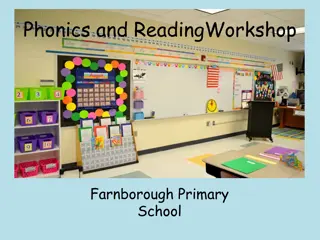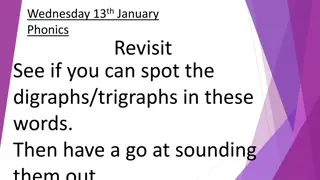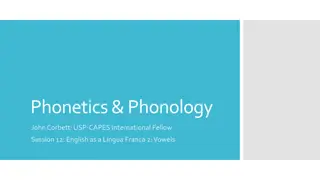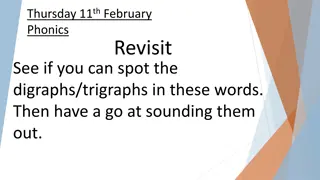Understanding Consonant Clusters in English
Consonant clusters are groups of consonants without vowels in between, found at the beginning, middle, or end of words. They play a crucial role in English pronunciation and word formation, with specific patterns and exceptions to consider. This guide provides insights into different types of conson
3 views • 18 slides
Lesson 95: Learning about the 'oi' and 'oy' Sounds
In lesson 95, students will learn about the 'oi' and 'oy' vowel digraphs through engaging activities and visual aids. The lesson covers words containing these sounds and helps students practice their pronunciation and spelling. By the end of the lesson, learners will have a solid understanding of wh
9 views • 86 slides
Understanding Language and Linguistics
Language is a fundamental aspect of human communication, encompassing spoken and signed forms. Linguistics delves into syntax, semantics, morphology, phonology, and phonetics to analyze language structure and meaning. Phonetics explores how speech sounds are produced and perceived, shedding light on
9 views • 10 slides
Introduction to Syllable Types
Delve into the world of phonetics with this informative content explaining vowel sounds, consonant sounds, and the concept of syllables. Discover the differences between short and long vowel sounds, voiced and unvoiced consonants, and how syllable types can aid in pronunciation. Engage in interactiv
2 views • 31 slides
Fun Word Lists for Consonant Blends & Short Vowels
Explore engaging word lists featuring consonant blends and short vowels, including two-letter blends (initial and final), mixed blends, and two & three-letter blends. Enhance vocabulary skills with words like stun, click, floss, loft, crunch, swift, squish, and more!
0 views • 13 slides
Consonant Blends & Short Vowels Word Cards Collection
Explore engaging word cards featuring two-letter blends (initial and final), as well as two and three-letter blends. Enhance literacy skills and phonics with words like stun, floss, nest, gilt, and more. Perfect for early learners and language development.
0 views • 4 slides
Spelling Rules for Adding Suffixes in English Writing
Explore the essential spelling rules for adding suffixes in English writing, including changing 'y' to 'i,' doubling the last consonant, and dropping 'e' before adding certain suffixes. Put these rules to the test by applying them to various words in practice.
1 views • 31 slides
Digraphs Review: Practice and Mastery in Lesson 49
Engage in a comprehensive review of digraphs through Lesson 49, focusing on strengthening your understanding and application of these essential language elements. Explore a series of engaging slides designed to reinforce your knowledge and provide opportunities for improvement in recognizing and usi
3 views • 90 slides
Adding -ing to Words Ending in -e with a Consonant: Spelling Rule Activity
Explore the spelling rule of adding -ing to words that end in -e with a consonant before it through engaging activities like spellings, word cards, and detective work. Reinforce the concept by practicing with words like hike, shine, joke, and more. Encourage children to discover how to transform roo
0 views • 8 slides
Phonics Detective Fun: Digraphs and Word Blending Activities
Join the Phonics Detective and warm up your brains with exciting activities focusing on digraphs, word blending, and sound recognition. Explore words like boat, moat, and flow to improve phonics skills. Identify where the digraph appears in words and practice blending sounds. Test your knowledge wit
0 views • 20 slides
Understanding the Use of A and An in English Grammar
Explore the concept of using "a" or "an" in English based on whether the following word starts with a consonant or a vowel. Learn about consonants and vowels, practice identifying them, and see examples of correct usage. Enhance your grammar skills with this engaging educational material.
1 views • 13 slides
Understanding English Consonant Sounds: A Detailed Guide
This guide delves into the English phonetics and linguistics classification of consonant sounds, emphasizing factors such as place of articulation and manner of articulation. It covers various types of consonant sounds, from bilabial and labio-dental to alveolar, post-alveolar, palatal, velar, and g
1 views • 11 slides
Understanding Monosyllabic Words in Luganda
Monosyllabic words in Luganda come in various forms, including vowels as exclamations or questions, consonant-vowel words with complete meanings, nasal-consonant-vowel words, double consonant-vowel words, and more. These words play different roles in expressing surprise, asking questions, or conveyi
0 views • 8 slides
Overview of Little Wandle Letters and Sounds Programme
Little Wandle Letters and Sounds Revised is a government-recommended phonics and early reading programme designed to help children fluently decode and read texts using phonics by the end of Year 1. Parents play a vital role in supporting children's reading development, as fluency by age 6 correlates
1 views • 18 slides
Understanding When to Use "A" or "An" in English Sentences
Learn the rules for when to use "a" versus "an" in English language. Use "a" before words starting with a consonant sound and "an" before words starting with a vowel sound. Mastering this concept will improve your grammar skills and enhance your written communication.
0 views • 19 slides
Engaging Visual Drill for Learning Consonant Digraphs
Improve phonics skills with this visually stimulating drill featuring consonant digraphs. Explore various examples and exercises through a series of interactive slides. Enhance language proficiency in an enjoyable way.
0 views • 7 slides
Exploring Mathematical Concepts Through Visual Representation
Delve into the world of mathematics through visual representations, from clock arithmetic to unary operators. Dive into the fascinating realm of magmas, digraphs, and adjacency matrices to understand complex mathematical operations in an accessible way.
0 views • 26 slides
Phonics and Reading Workshop at Farnborough Primary School
Explore the essence of phonics, encompassing the 44 sounds of the English language, blending skills for reading, tricky words, the Year 1 phonics screening test, and supporting reading at home. Learn the fundamentals of phonics, the alphabet, letter sounds, blending techniques, and practical exercis
0 views • 39 slides
Understanding Syllable Types in English Language
Syllables in English are categorized into open and closed syllables based on their endings. Open syllables have an onset and nucleus without a coda, while closed syllables include a coda. Additionally, syllables can be simple (with a vowel or single consonant) or complex (with consonant clusters). T
1 views • 6 slides
Phonics Learning Program for Children
Explore a comprehensive phonics learning program for children featuring Miss Billington and Mrs. Ghoul. Discover the synthetic phonics approach with 44 sounds, digraphs, and more. Learn about teaching methods, including Fred Talk and Fred Fingers, to enhance reading and writing skills. Find guidance
0 views • 17 slides
Short Vowel CVC Word Lists for Practice
Explore a comprehensive list of short vowel CVC (consonant-vowel-consonant) words perfect for practice and learning. From simple words like "cat" and "dog" to more complex ones like "mud" and "frog," this collection offers a great resource for improving phonics skills.
0 views • 37 slides
Consonant Digraphs with Short Vowels Word Lists
Explore word lists featuring common consonant digraphs like "sh," "ch," "th," "ck," and "qu" paired with short vowel sounds. Improve phonics skills and vocabulary recognition with words such as shop, ship, whiz, duck, lick, quack, and more.
0 views • 22 slides
Wednesday 13th January Phonics Revisit: Digraphs and Tricky Words Practice
Explore digraphs and tricky words in phonics practice - spot and sound out digraphs/trigraphs, decode upside down words, learn new sounds like "ir," and practice phoneme spotting. Engage in memory tests and find mistakes to enhance phonics skills.
0 views • 12 slides
Infant Phonetic Development: Stages and Characteristics
Infant phonetic development progresses through distinct stages, from basic biological noises like crying to babbling and beyond. Each stage highlights vocal milestones such as cooing, vocal play, and babbling, leading to the expansion and contraction of phonemes. The transition to melodic utterance
0 views • 5 slides
French Pronunciation Guide: Vowels, Nasal Sounds & Consonants
Explore the intricacies of French pronunciation through the International Phonetic Alphabet (IPA), understanding vowel sounds, nasal vowels, and consonant variations. Master the differences in sound production and learn how to correctly pronounce French words with detailed explanations and visual ai
0 views • 18 slides
Analysis of Poetic Techniques in "Mrs. Midas" Verses for Mood Creation
Late September in "Mrs. Midas", the use of poetic techniques such as personification, contrast in consonant sounds, and building tension through language effectively conveys the relaxed atmosphere changing to chaos. The language choice in building up to the climax adds to the absurdity and horror of
1 views • 9 slides
Understanding Phonics: The Key to Reading Success
Phonics is a method of teaching the connection between sounds and letters to help children learn to read and spell. It involves recognizing phonemes, blending sounds to form words, and assessing proficiency through screenings. The phases of phonics progress from basic letter sounds to more complex d
0 views • 30 slides
Insights on English Pronunciation Variations and Intelligibility in Language Teaching
Dive into the nuances of vowel articulations and consonant recommendations in English pronunciation. Explore the concept of Lingua Franca Core vowels and how variations among L1 English speakers impact intelligibility. Understand the importance of mutual intelligibility in non-native speaker communi
0 views • 15 slides
Phonics Revisit: Digraphs and Tricky Words Practice
Explore digraphs and trigraphs in words like "growl," "frown," "spear," and practice sounding out tricky words such as "come," "they," and "when." Learn about the sounds "ei" and "eigh" making the "ay sound" and practice spelling words like "eight," "eighty," and "neighbour." Test your memory with a
0 views • 9 slides
Learn About Articles in English Grammar Class
Discover the basics of articles in English grammar through a class aimed at class 8 students. Understand the types of articles, their usage, and when to use "a," "an," and "the." Dive into examples and rules surrounding indefinite and definite articles, along with practice exercises for identifying
0 views • 20 slides
An Alternative Phonetically-Based Phoneme Analysis of the Danish Consonant System
This study challenges the standard analysis of the Danish consonant system, proposing a new phonetically-based approach. It critiques the outdated standard analysis that links unaspirated plosives with semivowels, arguing that the alternative analysis is more in line with phonetic facts and easier t
0 views • 19 slides
Understanding Slavic Nominal Case Morphology & Stems
Uncover the intricacies of consonant-stem nominal case morphology in Slavic languages, from the introduction to the case system to the classification of consonant stems into major groups such as *u-stems, *n-stems, *s-stems, *nt-stems, and *r-stems. Explore the unique characteristics of *-stems, *o-
0 views • 11 slides
Comprehensive Consonant Study Guide
Enhance your understanding of consonants with detailed exercises and reviews covering various features like voicing, place, and manner of articulation. Discover different consonant groups and common characteristics shared among specific sounds.
0 views • 8 slides
Understanding Adjective Comparison in English Grammar
Explore the rules for forming comparative and superlative forms of adjectives in English grammar. Learn about irregular comparisons, one-syllable adjectives, adjectives ending in -y, -ow, -le, -er, multi-syllable adjectives, hyphenated adjectives, and more. Discover the nuances of adjectives with on
0 views • 14 slides
Learning Phonics and Vocabulary in Early Education
Breaking down words into sounds, understanding phonemes, CVC words, mnemonic techniques, tricky words, segmenting, blending, digraphs, and consolidating learning through the 6 phases of Letters and Sounds in early education to develop foundational language skills.
0 views • 13 slides
Understanding Hebrew Verb Forms: Qal Qatal and Piel Qatal Paradigms
Explore the rules and nuances of using definite articles with prepositions, verb forms, and verb charts in Hebrew. Learn how to identify and read the Qal Qatal and Piel Qatal paradigms, and understand the significance of prepositions with the definite article. Dive into verb charts for Qatal and dec
0 views • 25 slides
Remote Learning Phonics Lesson Outline for Reception Students
In this remote learning session, Reception students will review Phase 2 and 3 phonemes, digraphs, and tricky words. They will learn and practice new tricky words, practice writing them, and read sentences containing tricky words. The lesson includes various visual aids and slides to engage students
0 views • 70 slides
Consonant Digraphs with Short Vowels Word Cards
Explore word cards featuring consonant digraphs "sh," "ch," "th," "ck," and "qu" paired with short vowels. Practice reading words like ship, thick, duck, and quit to strengthen phonics skills in a fun and engaging way.
0 views • 6 slides
Exploring Monosyllabic and Polysyllabic Words in Luganda
Discover the structure of monosyllabic words in Luganda consisting of consonant-semi-vowel-vowel patterns like Lwa and Gwa, as well as those with consonant-consonant-semi-vowel-vowel patterns like Mbwa and Nswa. Further explore the realm of polysyllabic words in Luganda, where each syllable ends wit
0 views • 4 slides
Remote Learning Phonics Lesson for Reception Students
In this remote learning session, Reception students will recap phase 2 and practice phase 3 tricky words, phonemes, digraphs, and trigraphs. They will learn a new trigraph sound, read and write new words and sentences. The lesson includes interactive slides to engage students in independent tasks re
0 views • 73 slides







































